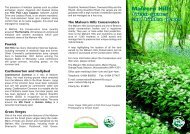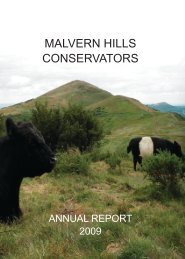Footpath degradation of the Malvern Hills - Malvern Hills Conservators
Footpath degradation of the Malvern Hills - Malvern Hills Conservators
Footpath degradation of the Malvern Hills - Malvern Hills Conservators
You also want an ePaper? Increase the reach of your titles
YUMPU automatically turns print PDFs into web optimized ePapers that Google loves.
Stephen Britnell<br />
<strong>Footpath</strong> <strong>degradation</strong> <strong>of</strong> <strong>the</strong> <strong>Malvern</strong> <strong>Hills</strong><br />
enlarged. Pigeonholes generally form on vegetated paths, and are signs <strong>of</strong> initial vegetation<br />
breakdown, and that fur<strong>the</strong>r problems are ahead. In conclusion, slope angle thresholds can<br />
be stated for 1) braiding 0 to 15 degrees, 2) gullying 6 to 20 degrees, and 3) pigeonholes 11<br />
to 26 degrees. There has been no previous work on this subject for comparison, but I feel that<br />
<strong>the</strong>se relationships are strongly correlated.<br />
5.2.4 Path angle<br />
Previous findings by Leung et al. (1996) shows that <strong>the</strong>re is a negative correlation<br />
between path angle and erosion, suggesting that as path angle decreases erosion increases.<br />
This trend is weakly reinforced through my own study. By looking all <strong>the</strong> footpaths as a whole<br />
it was concluded through <strong>the</strong> use <strong>of</strong> Pearson’s correlation that <strong>the</strong>re is no relationship<br />
between path angle and erosion. However, looking specifically at path 5, End Hill, <strong>the</strong>re is a<br />
strong negative relationship between path angle and <strong>the</strong> width and depth <strong>of</strong> scarring, and a<br />
good negative relationship between path angle and <strong>the</strong> width <strong>of</strong> worn vegetation (see Table<br />
4). Path 5 is particularly suitable for <strong>the</strong> study <strong>of</strong> path angle and erosion in detail, as path<br />
angle alters distinctly from running parallel to <strong>the</strong> slope at 0 degrees, to cutting diagonally<br />
across <strong>the</strong> slope at 46 degrees, and <strong>the</strong>n back to parallel at 4 degrees. Therefore this shows<br />
a good variation in path angle.<br />
My own findings agree with that <strong>of</strong> Leung et al. (1996), although I believe that path<br />
angle is only a weak controlling variable over erosion. This may be because <strong>the</strong> effect <strong>of</strong> path<br />
is controlled by <strong>the</strong> slope angle <strong>of</strong> <strong>the</strong> path. Evidence for this assumption comes from<br />
comparison between paths 7 and 11. Both paths have similar path angles <strong>of</strong> around 90<br />
degrees, and follow <strong>the</strong> contours <strong>of</strong> <strong>the</strong> hill. Both are popular paths, though <strong>the</strong> main<br />
difference between <strong>the</strong>m is slope angle. Path 11 is very flat with a maximum slope <strong>of</strong> 4<br />
degrees, path 7 conversely ranges from 6 to 14 degrees. Path 7 is greater eroded than 11 so<br />
<strong>the</strong> controlling factor must be path slope causing <strong>the</strong> path to act more like a channel so being<br />
eroded more greatly by water.<br />
42





